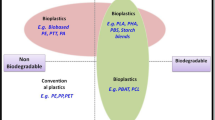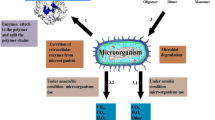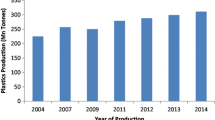Abstract
With the increasing use of fossil-based plastics worldwide, the need for proper disposal of plastic waste has become a menace for develo** countries as well as the developed world. The overuse of plastic and its improper disposal system in many countries of the world has led to severe environmental concerns. Disposal system and methods of plastic through various chemical and physical processes are very expensive which also produces organic pollutants, resulting in environmental deterioration. Recent trends suggest the biodegradation of conventional plastics like polyethylene terephthalate (PET), polyethylene (PE), and polystyrene (PS) under different environments like using enzymes and microbes for disintegration and assimilation, respectively, as a viable bioremediation. Among enzymes, lipases, cutinases, and PETase has been identified as potential fossil-based plastic degrader as viable solution. This chapter aims to provide a broader aspect of conventional plastic biodegradation and its degradation mechanisms, providing an overview on viable bioremediation of plastic waste. This chapter also discusses the current status of the techniques used for degradation, characterizing degraded plastics and factors affecting their biodegradation.
Access this chapter
Tax calculation will be finalised at checkout
Purchases are for personal use only
Similar content being viewed by others
References
Zheng Y, Yanful EK, Bassi AS (2005) A review of plastic waste biodegradation. Crit Rev Biotechnol 25:243–250. https://doi.org/10.1080/07388550500346359
Valapa RB, Pugazhenthi G, Katiyar V (2016) Hydrolytic degradation behaviour of sucrose palmitate reinforced poly(lactic acid) nanocomposites. Int J Biol Macromol 89:70–80. https://doi.org/10.1016/j.ijbiomac.2016.04.040
Dhar P, Bhasney SM, Kumar A, Katiyar V (2016) Acid functionalized cellulose nanocrystals and its effect on mechanical, thermal, crystallization and surfaces properties of poly (lactic acid) bionanocomposites films: a comprehensive study. Polymer (UK) 101:75–92. https://doi.org/10.1016/j.polymer.2016.08.028
Gupta A, Pal AK, Woo EM, Katiyar V (2018) Effects of amphiphilic chitosan on stereocomplexation and properties of poly(lactic acid) nano-biocomposite. Sci Rep 8:1–13. https://doi.org/10.1038/s41598-018-22281-1
Pal AK, Katiyar V (2016) Nanoamphiphilic chitosan dispersed poly (lactic acid) bionanocomposite films with improved thermal. Mech Gas Barrier Prop. https://doi.org/10.1021/acs.biomac.6b00619
Pradhan R, Misra M, Erickson L, Mohanty A (2010) Compostability and biodegradation study of PLA-wheat straw and PLA-soy straw based green composites in simulated composting bioreactor. Bioresour Technol 101:8489–8491. https://doi.org/10.1016/j.biortech.2010.06.053
Kalita NK, Nagar MK, Mudenur C et al (2019) Biodegradation of modified Poly(lactic acid) based biocomposite films under thermophilic composting conditions. Polym Test. https://doi.org/10.1016/j.polymertesting.2019.02.021
Gupta A, Mulchandani N, Shah M et al (2018) Functionalized chitosan mediated stereocomplexation of poly(lactic acid): influence on crystallization, oxygen permeability, wettability and biocompatibility behavior. Polymer (UK) 142:196–208. https://doi.org/10.1016/j.polymer.2017.12.064
Wei R, Zimmermann W (2017) Microbial enzymes for the recycling of recalcitrant petroleum-based plastics: how far are we? Microb Biotechnol 10:1308–1322. https://doi.org/10.1111/1751-7915.12710
Vimal Kumar R, Kanna GR, Elumalai S (2017) Biodegradation of polyethylene by green photosynthetic microalgae. J Bioremediat Biodegrad 8:1–8. https://doi.org/10.4172/2155-6199.1000381
Valapa RB, Pugazhenthi G, Katiyar V (2016a) Hydrolytic degradation behaviour of sucrose palmitate reinforced poly(lactic acid) nanocomposites. Int J Biol Macromol 89:70–80. https://doi.org/10.1016/j.ijbiomac.2016.04.040
Pradhan R, Reddy M, Diebel W et al (2010b) Comparative compostability and biodegradation studies of various components of green composites and their blends in simulated aerobic composting bioreactor. Int J Plast Technol 14. https://doi.org/10.1007/s12588-010-0009-z
Yoshida S, Hiraga K, Takanaha T et al (2016) A bacterium that degrades and assimilates poly(ethyleneterephthalate). Science (80)351:1196–1199. https://doi.org/10.1126/science.aad6359
Kitadokoro K, Thumarat U, Nakamura R et al (2012) Crystal structure of cutinase Est119 from Thermobifida alba AHK119 that can degrade modified polyethylene terephthalate at 1.76 Å resolution. Polym Degrad Stab 97:771–775. https://doi.org/10.1016/j.polymdegradstab.2012.02.003
Gnanavel G, Mohana Jeya Valli VP, Thirumarimurugan Kannadasan T (2012) Degradation of plastics using microorganisms. Int J Pharm Chem Sci 1:1040–1043
Tripathi N, Katiyar V (2017) Poly (lactic acid)/modified gum arabic based bionanocomposite films: thermal degradation kinetics. https://doi.org/10.1002/pen
Kale SK, Deshmukh AG, Dudhare MS, Patil VB (2015) Microbial degradation of plastic: a review. J Biochem Technol 6:952–961. https://doi.org/10.5897/AJMR2016.8402
Singh B, Sharma N (2008) Mechanistic implications of plastic degradation. Polym Degrad Stab 93:561–584. https://doi.org/10.1016/j.polymdegradstab.2007.11.008
Tokiwa Y, Calabia BP, Ugwu CU, Aiba S (2009) Biodegradability of plastics. Int J Mol Sci 10:3722–3742. https://doi.org/10.3390/ijms10093722
Kale (2015) Microbial degradation of plastics: a review. J Biochem Technol 6:952–961. https://doi.org/10.1504/ijep.2008.016895
Yang J, Yang Y, Wu WM et al (2014) Evidence of polyethylene biodegradation by bacterial strains from the guts of plastic-eating waxworms. Environ Sci Technol 48:13776–13784. https://doi.org/10.1021/es504038a
Yang Y, Yang J, Wu WM et al (2015) Biodegradation and mineralization of polystyrene by plastic-eating mealworms: part 2. role of gut microorganisms. Environ Sci Technol 49:12087–12093. https://doi.org/10.1021/acs.est.5b02663
Eubeler JP, Bernhard M, Knepper TP (2010) Environmental biodegradation of synthetic polymers II. Biodegradation of different polymer groups. TrAC Trends Anal Chem 29:84–100. https://doi.org/10.1016/j.trac.2009.09.005
Gu JD (2003) Microbiological deterioration and degradation of synthetic polymeric materials: Recent research advances. Int Biodeterior Biodegrad 52:69–91
Krueger MC, Harms H, Schlosser D (2015) Prospects for microbiological solutions to environmental pollution with plastics. Appl Microbiol Biotechnol 99:8857–8874. https://doi.org/10.1007/s00253-015-6879-4
Lucas N, Bienaime C, Belloy C et al (2008) Polymer biodegradation: mechanisms and estimation techniques—a review. Chemosphere 73:429–442. https://doi.org/10.1016/j.chemosphere.2008.06.064
Shah AA, Hasan F, Hameed A, Ahmed S (2008) Biological degradation of plastics: a comprehensive review. Biotechnol Adv 26:246–265. https://doi.org/10.1016/j.biotechadv.2007.12.005
Sivan A (2011) New perspectives in plastic biodegradation. Curr Opin Biotechnol 22:422–426. https://doi.org/10.1016/j.copbio.2011.01.013
Bhardwaj H, Gupta R, Tiwari A (2013) Communities of microbial enzymes associated with biodegradation of plastics. J Polym Environ 21:575–579. https://doi.org/10.1007/s10924-012-0456-z
Heredia A (2003) Biophysical and biochemical characteristics of cutin, a plant barrier biopolymer. Biochim Biophys Acta Gen Subj 1620:1–7. https://doi.org/10.1016/S0304-4165(02)00510-X
Thumarat U, Nakamura R, Kawabata T et al (2012) Biochemical and genetic analysis of a cutinase-type polyesterase from a thermophilic Thermobifida alba AHK119. Appl Microbiol Biotechnol 95:419–430. https://doi.org/10.1007/s00253-011-3781-6
Restrepo-Flórez JM, Bassi A, Thompson MR (2014) Microbial degradation and deterioration of polyethylene—a review. Int Biodeterior Biodegrad 88:83–90. https://doi.org/10.1016/j.ibiod.2013.12.014
Webb HK, Arnott J, Crawford RJ, Ivanova EP (2013) Plastic degradation and its environmental implications with special reference to poly(ethylene terephthalate). Polymers (Basel) 5:1–18. https://doi.org/10.3390/polym5010001
Cregut M, Bedas M, Durand MJ, Thouand G (2013) New insights into polyurethane biodegradation and realistic prospects for the development of a sustainable waste recycling process. Biotechnol Adv 31:1634–3647. https://doi.org/10.1016/j.biotechadv.2013.08.011
Bonhomme S, Cuer A, Delort AM et al (2003) Environmental biodegradation of polyethylene. Polym Degrad Stab 81:441–452. https://doi.org/10.1016/S0141-3910(03)00129-0
Hakkarainen M, Karlsson S, Albertsson A (2000) Rapid (bio) degradation of polylactide by mixed culture of compost microorganisms—low molecular weight products and matrix changes. Polymer (Guildf) 41:2331–2338
Arkatkar A, Juwarkar AA, Bhaduri S et al (2010) Growth of Pseudomonas and Bacillus biofilms on pretreated polypropylene surface. Int Biodeterior Biodegrad 64:530–536. https://doi.org/10.1016/j.ibiod.2010.06.002
Arutchelvi J, Sudhakar M, Arkatkar A et al (2008) Biodegradation of polyethylene and polypropylene. Indian J Biotechnol 7:9–22
Mueller RJ (2006) Biological degradation of synthetic polyesters-enzymes as potential catalysts for polyester recycling. Process Biochem 41:2124–2128. https://doi.org/10.1016/j.procbio.2006.05.018
Loredo-Treviño A, Gutiérrez-Sánchez G, Rodríguez-Herrera R, Aguilar CN (2012) Microbial enzymes involved in polyurethane biodegradation: a review. J Polym Environ 20:258–265. https://doi.org/10.1007/s10924-011-0390-5
Espino-Rammer L, Ribitsch D, Przylucka A et al (2013) Two novel class ii hydrophobins from Trichoderma spp. Stimulate enzymatic hydrolysis of poly(ethylene terephthalate) when expressed as fusion proteins. Appl Environ Microbiol 79:4230–4238. https://doi.org/10.1128/AEM.01132-13
Ribitsch D, Acero EH, Przylucka A et al (2015) Enhanced cutinase-catalyzed hydrolysis of polyethylene terephthalate by covalent fusion to hydrophobins. Appl Environ Microbiol 81:3586–3592. https://doi.org/10.1128/AEM.04111-14
Sammond DW, Yarbrough JM, Mansfield E et al (2014) Predicting enzyme adsorption to lignin films by calculating enzyme surface hydrophobicity. J Biol Chem 289:20960–20969. https://doi.org/10.1074/jbc.M114.573642
Gamerith C, Herrero Acero E, Pellis A et al (2016) Improving enzymatic polyurethane hydrolysis by tuning enzyme sorption. Polym Degrad Stab 132:69–77. https://doi.org/10.1016/j.polymdegradstab.2016.02.025
Sarkar S, Singha PK, Dey S et al (2006) Synthesis, characterization, and cytotoxicity analysis of a biodegradable polyurethane. Mater Manuf Process 21:291–296. https://doi.org/10.1080/10426910500464727
Manzur A, Cuamatzi F, Favela E (1997) Effect of the growth of Phanerochaete chrysosporium in a blend of low density polyethylene and sugar cane bagasse. J Appl Polym Sci 66:105–111. https://doi.org/10.1002/(SICI)1097-4628(19971003)66:1%3c105:AID-APP12%3e3.3.CO;2-3
Albertsson AC, Andersson SO, Karlsson S (1987) The mechanism of biodegradation of polyethylene. Polym Degrad Stab 18:73–87. https://doi.org/10.1016/0141-3910(87)90084-X
Koutny M, Sancelme M, Dabin C et al (2006) Acquired biodegradability of polyethylenes containing pro-oxidant additives. Polym Degrad Stab 91:1495–1503. https://doi.org/10.1016/j.polymdegradstab.2005.10.007
Li YF, Wu CJ, Sheng YJ, Tsao HK (2015) Facile manipulation of receding contact angles of a substrate by roughening and fluorination. Appl Surf Sci 355:127–132. https://doi.org/10.1016/j.apsusc.2015.07.078
Fontanella S, Bonhomme S, Koutny M et al (2010) Comparison of the biodegradability of various polyethylene films containing pro-oxidant additives. Polym Degrad Stab 95:1011–1021. https://doi.org/10.1016/j.polymdegradstab.2010.03.009
Kumar Sen S, Raut S (2015) Microbial degradation of low density polyethylene (LDPE): A review. J Environ Chem Eng 3:462–473. https://doi.org/10.1016/j.jece.2015.01.003
Ojha N, Pradhan N, Singh S et al (2017) Evaluation of HDPE and LDPE degradation by fungus, implemented by statistical optimization. Sci Rep 7:1–13. https://doi.org/10.1038/srep39515
Santo M, Weitsman R, Sivan A (2013) The role of the copper-binding enzyme—laccase—in the biodegradation of polyethylene by the actinomycete Rhodococcus ruber. Int Biodeterior Biodegrad 84:204–210. https://doi.org/10.1016/j.ibiod.2012.03.001
Roy PK, Titus S, Surekha P et al (2008) Degradation of abiotically aged LDPE films containing pro-oxidant by bacterial consortium. Polym Degrad Stab 93:1917–1922. https://doi.org/10.1016/j.polymdegradstab.2008.07.016
Esmaeili A, Pourbabaee AA, Alikhani HA et al (2013) Biodegradation of low-density polyethylene (LDPE) by mixed culture of Lysinibacillus xylanilyticus and Aspergillus niger in soil. PLoS One 8. https://doi.org/10.1371/journal.pone.0071720
Mukherjee S, Roy Chowdhuri U, Kundu PP (2016) Bio-degradation of polyethylene waste by simultaneous use of two bacteria: Bacillus licheniformis for production of bio-surfactant and Lysinibacillus fusiformis for bio-degradation. RSC Adv 6:2982–2992. https://doi.org/10.1039/c5ra25128a
Seymour RB, Kauffman GB (1992) Polyurethanes: a class of modern versatile materials. J Chem Educ 69:909. https://doi.org/10.1021/ed069p909
Nakajima-Kambe T, Shigeno-Akutsu Y, Nomura N et al (1999) Microbial degradation of polyurethane, polyester polyurethanes and polyether polyurethanes. Appl Microbiol Biotechnol 51:134–140. https://doi.org/10.1007/s002530051373
Howard G (2011) Microbial biodegradation of polyurethane. Recent Dev Polym Recycl 661:215–238
Stern RV, Howard GT (2000) The polyester polyurethanase gene (pueA) from Pseudomonas chlororaphis encodes a lipase. FEMS Microbiol Lett 185:163–168. https://doi.org/10.1016/S0378-1097(00)00094-X
Kawai F, Oda M, Tamashiro T et al (2014) A novel Ca2+-activated, thermostabilized polyesterase capable of hydrolyzing polyethylene terephthalate from Saccharomonospora viridis AHK190. Appl Microbiol Biotechnol 98:10053–10064. https://doi.org/10.1007/s00253-014-5860-y
Author information
Authors and Affiliations
Corresponding author
Editor information
Editors and Affiliations
Rights and permissions
Copyright information
© 2020 Springer Nature Singapore Pte Ltd.
About this chapter
Cite this chapter
Kalita, N.K., Kalamdhad, A., Katiyar, V. (2020). Recent Trends and Advances in the Biodegradation of Conventional Plastics. In: Katiyar, V., Kumar, A., Mulchandani, N. (eds) Advances in Sustainable Polymers. Materials Horizons: From Nature to Nanomaterials. Springer, Singapore. https://doi.org/10.1007/978-981-15-1251-3_17
Download citation
DOI: https://doi.org/10.1007/978-981-15-1251-3_17
Published:
Publisher Name: Springer, Singapore
Print ISBN: 978-981-15-1250-6
Online ISBN: 978-981-15-1251-3
eBook Packages: Chemistry and Materials ScienceChemistry and Material Science (R0)




